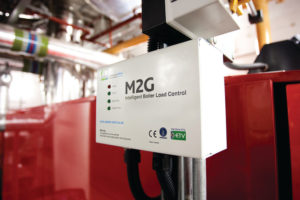There are a number of misconceptions regarding retrofit boiler controls that can lead to savings opportunities being missed, or energy-saving projects that fail to deliver on expectations.
1. The BMS takes care of everything
Typically a building management system (BMS) is programmed to manage the heating system as a whole by monitoring the blended water temperatures from all of the boilers rather than measuring the individual boiler(s). Consequently any energy wastage through boiler dry cycling at an individual boiler level is not always detected or prevented by the BMS. It is possible to configure a BMS to monitor dry cycling but this requires expensive bespoke programming, generally at a cost that greatly exceeds that of introducing retrofit boiler load controls.
2. Dry cycling does not occur with new boilers
Boiler dry cycling can occur with virtually all types of boilers. When the boiler is no longer firing, the temperature of the water in the boiler eventually falls below the boiler’s internal set point due to natural “standing losses”. This triggers the boiler to fire, even when there is no requirement for heat from the building, thus wasting energy. Well-insulated and low water content modern boilers will cool more slowly compared to older less insulated boilers, so the dry cycling may be less frequent – but it will still occur.
3. Retrofit controls interfere with the existing control strategy
It is certainly true that some attempts to prevent boiler dry cycling conflict with existing control strategies. However, this can be avoided with the latest “Stop-Go”boiler load control technology.
Sabien’s patented M2G boiler load controller constantly analyses the temperature profile of each boiler in real time, dynamically identifying and preventing boiler dry cycling. More importantly, it also allows the boiler to fire immediately if there is a genuine demand for heat. If a BMS is in place, the M2G integrates with it, taking its ‘Stop-Go’ signal directly from the BMS. Just as importantly, it recalculates the values every time the boiler reaches its required set point temperature so there is no conflict and the boilers’ designed set points are never altered.
4. Reduced firing time = reduced gas consumption
Some retrofit boiler controls delay the firing of the boiler, working on the assumption that less firing equals lower fuel consumption. However, most modern boilers use a modulating burner or multi stage firing, and a boiler firing for five minutes at low fire will use much less fuel than if it was operating for five minutes at high fire. Therefore the firing time of the boiler does not equate to the energy used.
5. Energy bills are an accurate guide to energy savings
Energy bills typically detail gross consumption of energy (for example, gas) without differentiating between various uses (heating, catering) so they are not an accurate guide to any savings that may have been made by a particular energy-saving initiative. Also, the energy consumption of heating plant needs to be related to weather conditions using degree day data provided by the Meteorological Office. A direct comparison of gas consumption between a cold and mild winter is meaningless.
Any other factors affecting heating patterns (changes in building fabric, occupation densities etc) should also be accounted for. We recommend using the International Performance Measurement and Verification Protocol (IPMVP).
For further information www.sabien-tech.co.uk




